A Note on Rational Lagrange Polynomials for CAGD Applications and Isogeometric Analysis
Abstract
1. Introduction
2. General Formulation
2.1. Degree Elevation Using Bernstein–Bézier Polynomials
2.2. Replacing Bernstein Polynomials with Lagrange Polynomials
2.3. Determination of Transformation Matrix
2.3.1. Detailed Algebraic Procedure
2.3.2. A Shorter Numerical Procedure
2.4. From Approximation Theory and Numerical Analysis to CAGD
2.5. General Procedure for the Determination of Transformation Matrix
2.5.1. Uniform Points
2.5.2. Non-Uniform Points
3. Weights
3.1. Circular Arc with Central Angle 90°
3.1.1. Uniform Distribution
3.1.2. Non-Uniform Distribution
- Straight segment
- II.
- Circular arc
3.2. Central Angle Different than 90°
4. Examples
4.1. Example 1: The Case of Degree p = 2
4.2. Example 2: The Case of Degree p = 3
4.2.1. Straight Line
- When , the mapping is uniform, i.e., .
- In contrast, when , the mapping is non-uniform.
4.2.2. Circular Arc of
- It is generally not possible to represent a circular arc accurately using equidistant nodal points, even with rational Lagrange polynomials. By employing optimization techniques, where an objective function such as is minimized, a value of can be determined that approximately satisfies for . Nevertheless, small deviations from the ideal circle remain (e.g., beyond the fourth decimal place).
4.3. Example 3: The Case of Degree p = 5
5. Spherical Cap
- Calculate projected control points and associated weights . This is implemented using the abovementioned built-in MATLAB function:
- Create the total transformation matrix , of size (see below). In more detail, if the one-dimensional matrix of Equation (51) is shortly written asthe 2D analog—applied to a surface patch—becomes
- Multiply the control points by the abovementioned and thus determine the projected nodal points :
- Multiply the weights vector by the abovementioned and thus derive the weights associated with Lagrange polynomials:
6. Generalization to Arbitrary Tensor-Product Surfaces
6.1. General Approach
- Define the Parametric Grid: A structured grid of parameters is defined in the unit square . This grid establishes the topology of the Lagrange patch. The nodal parameters can be set, for instance, to and for a surface of degree in the -direction and in the -direction. Non-uniform sets and are acceptable as well.
- Construct Basis Functions: The corresponding sets of Lagrange polynomials and are constructed. These polynomials satisfy the cardinal property .
- Initialize the Rational Basis: Rational basis functions are formally constructed from these Lagrange polynomials and unknown weights . As an initial step for numerical solvers, all weights can be set to 1.
- Objective Function (Data Fitting): Surface must approximate a set of M data points sampled from the target surface ( must not be confused with control points). This leads to the objective function being minimized:
- Nonlinear Constraints (Geometric Fidelity): Nodal points must satisfy the implicit equations defining the target surface’s geometry. For a surface defined by , this imposes the constraints
6.1.1. General Algorithm
6.1.2. Efficient Algorithm
- (a)
- Linear Nodal Point Solve: With the weights fixed at their current values, the determination of the nodal points becomes a linear least-squares problem. We solve this efficiently for the best-fit nodal net.
- (b)
- Nonlinear Weight Update: Holding the newly computed nodal points constant, we perform a lightweight nonlinear optimization to update only the weights. This step adjusts the rational basis functions to better match the intrinsic curvature of the target surface.
- (c)
- Check Convergence: We iterate between steps (a) and (b) until the change in the solution is negligible.
- Efficiency: It leverages highly optimized linear algebra solvers for the most expensive step (finding the nodal net).
- Robustness: It avoids the pitfalls of initializing a full nonlinear solver with a poor guess. Starting with weights=1 provides a sensible, neutral starting point.
- Theoretical Foundation: This method can be viewed as a variant of the Gauss–Newton algorithm for nonlinear least squares, applied specifically to the structure of our problem.
6.2. Illustrative Example: A 90-Degree Circular Arc
6.3. Remarks on Trivial Cases
7. A Boundary-Value Problem
7.1. The Proposed Approach
7.2. Standard IGA Approach
7.3. Results
8. Discussion
9. Conclusions
Funding
Data Availability Statement
Conflicts of Interest
References
- Farin, G. Curves and Surfaces for CAGD: A Practical Guide, 5th ed.; Morgan Kaufmann: San Francisco, CA, USA, 2002. [Google Scholar]
- Piegl, L.; Tiller, W. The NURBS Book, 2nd ed.; Springer: Berlin/Heidelberg, Germany, 1997. [Google Scholar]
- Hoschek, J.; Lasser, D. Fundamentals of Computer Aided Geometric Design, 2nd ed.; A.K. Peters: Wellesley, MA, USA, 1996. [Google Scholar]
- Hughes, T.J.R.; Cottrell, J.A.; Bazilevs, Y. Isogeometric analysis: CAD, finite elements, NURBS, exact geometry and mesh refinement. Comput. Methods Appl. Mech. Eng. 2005, 194, 4135–4195. [Google Scholar] [CrossRef]
- Desiderio, L.; D’Inverno, G.A.; Sampoli, M.L.; Sestini, A. Hierarchical matrices for 3D Helmholtz problems in the multi-patch IgA-BEM setting. Eng. Comput. 2025, 41, 2021–2042. [Google Scholar] [CrossRef]
- Schillinger, D.; Ruthala, P.K.; Nguyen, L.H. Lagrange extraction and projection for NURBS basis functions: A direct link between isogeometric and standard nodal finite element formulations. Int. J. Numer. Methods Eng. 2016, 108, 515–534. [Google Scholar] [CrossRef]
- Liu, B.; Xing, Y.; Wang, Z.; Lu, X.; Sun, H. Non-uniform rational Lagrange functions and its applications to isogeometric analysis of in-plane and flexural vibration of thin plates. Comput. Methods Appl. Mech. Eng. 2017, 321, 173–208. [Google Scholar] [CrossRef]
- Lu, L.Z. Adaptive Polynomial Approximation to Circular Arcs. Appl. Mech. Mater. 2011, 50, 678–682. [Google Scholar] [CrossRef]
- Vavpetič, A. Optimal parametric interpolants of circular arcs. Comput. Aided Geom. Des. 2020, 80, 101891. [Google Scholar] [CrossRef]
- Vavpetič, A.; Žagar, E. A general framework for the optimal approximation of circular arcs by parametric polynomial curves. J. Comput. Appl. Math. 2019, 345, 146–158. [Google Scholar] [CrossRef]
- Vavpetič, A.; Žagar, E. On optimal polynomial geometric interpolation of circular arcs according to the Hausdorff distance. J. Comput. Appl. Math. 2021, 392, 113491. [Google Scholar] [CrossRef]
- De Boor, C. A Practical Guide to Splines, Revised ed.; Applied Mathematical Sciences; Springer: New York, NY, USA, 2001. [Google Scholar]
- Patera, A.T. A spectral element method for fluid dynamics: Laminar flow in a channel expansion. J. Comput. Phys. 1984, 54, 468–488. [Google Scholar] [CrossRef]
- Pozrikidis, C. Introduction to Finite and Spectral Element Methods Using MATLAB, 2nd ed.; CRC Press: Boca-Raton, FL, USA, 2014. [Google Scholar]
- Eisenträger, S.; Eisenträger, J.; Gravenkamp, H.; Provatidis, C.G. High order transition elements: The xNy-element concept-part II: Dynamics. Comput. Methods Appl. Mech. Eng. 2021, 387, 114145. [Google Scholar] [CrossRef]
- Provatidis, C.G. Precursors of Isogeometric Analysis: Finite Elements, Boundary Elements, and Collocation Methods; Solid Mechanics and Its Applications; Springer International Publishing: Cham, Switzerland, 2019. [Google Scholar] [CrossRef]
- Piegl, L.; Tiller, W. A menagerie of rational B-spline circles. IEEE Comput. Graph. Appl. 1989, 9, 48–56. [Google Scholar] [CrossRef]
- Provatidis, C. How accurately can spherical caps be represented by rational quadratic polynomials? WSEAS Trans. Circuits Syst. 2021, 20, 139–146. [Google Scholar] [CrossRef]
- Cobb, J.E. Tiling the Sphere with Rational Bézier Patches, TR UUCS-88-009. 1988. Available online: https://core.ac.uk/download/pdf/276277507.pdf (accessed on 9 May 2025).
- Levenberg, K. A Method for the Solution of Certain Problems in Least-Squares. Q. Appl. Math. 1944, 2, 164–168. [Google Scholar] [CrossRef]
- Marquardt, D. An Algorithm for Least-squares Estimation of Nonlinear Parameters. SIAM J. Appl. Math. 1963, 11, 431–441. [Google Scholar] [CrossRef]
- Carslaw, H.S.; Jaeger, J.C. Conduct. Heat Solids, 2nd ed.; Oxford University Press: Oxford, UK, 1969. [Google Scholar]
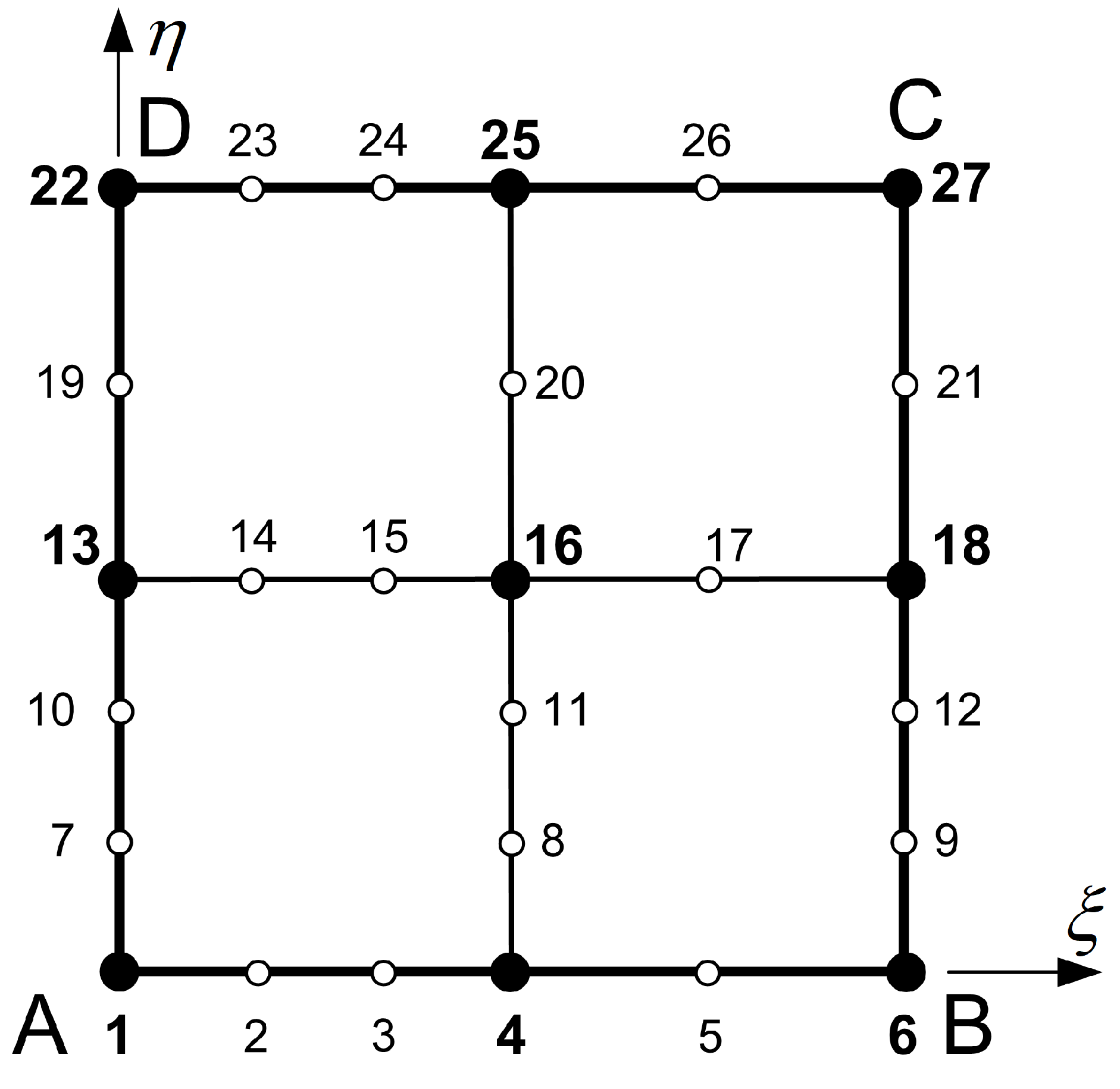

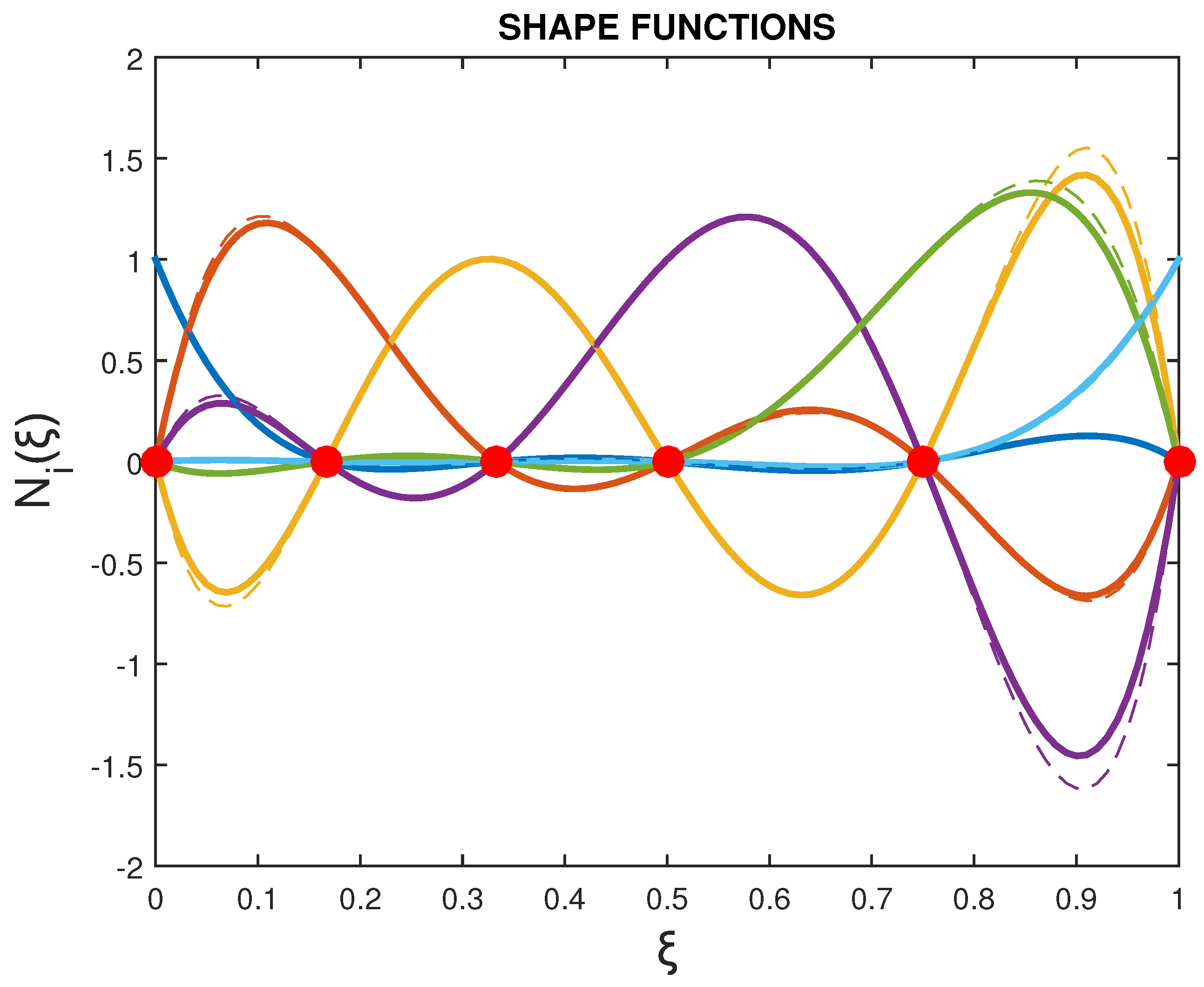
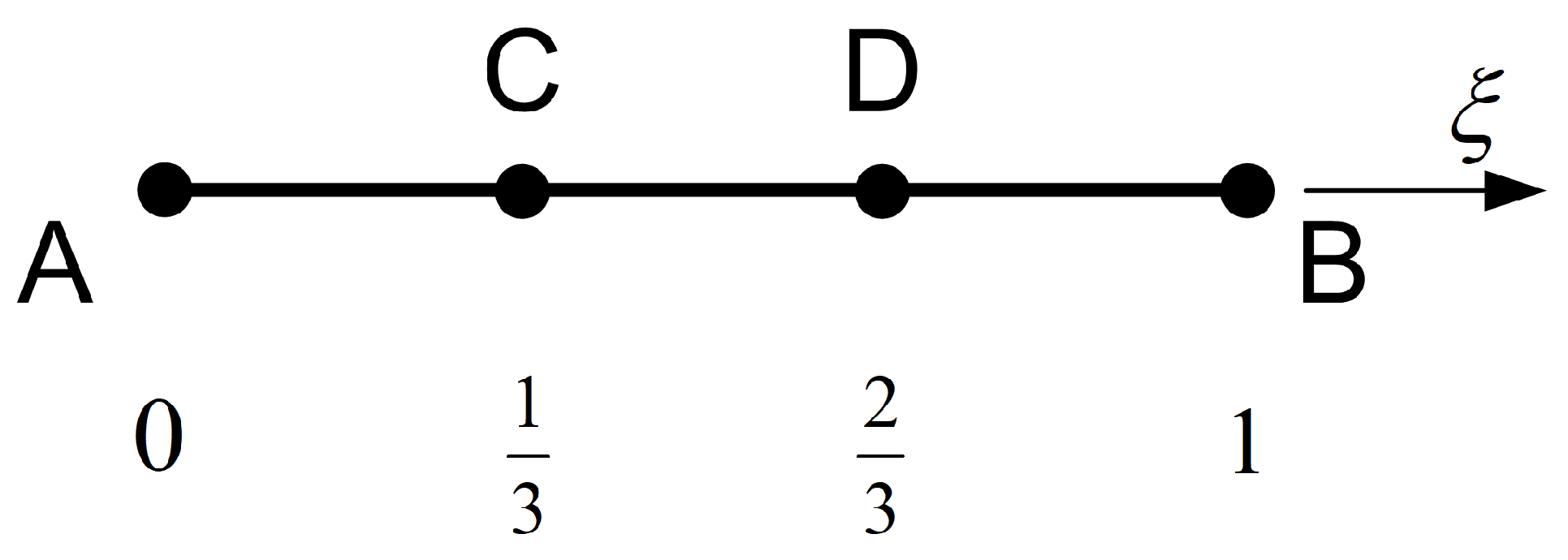
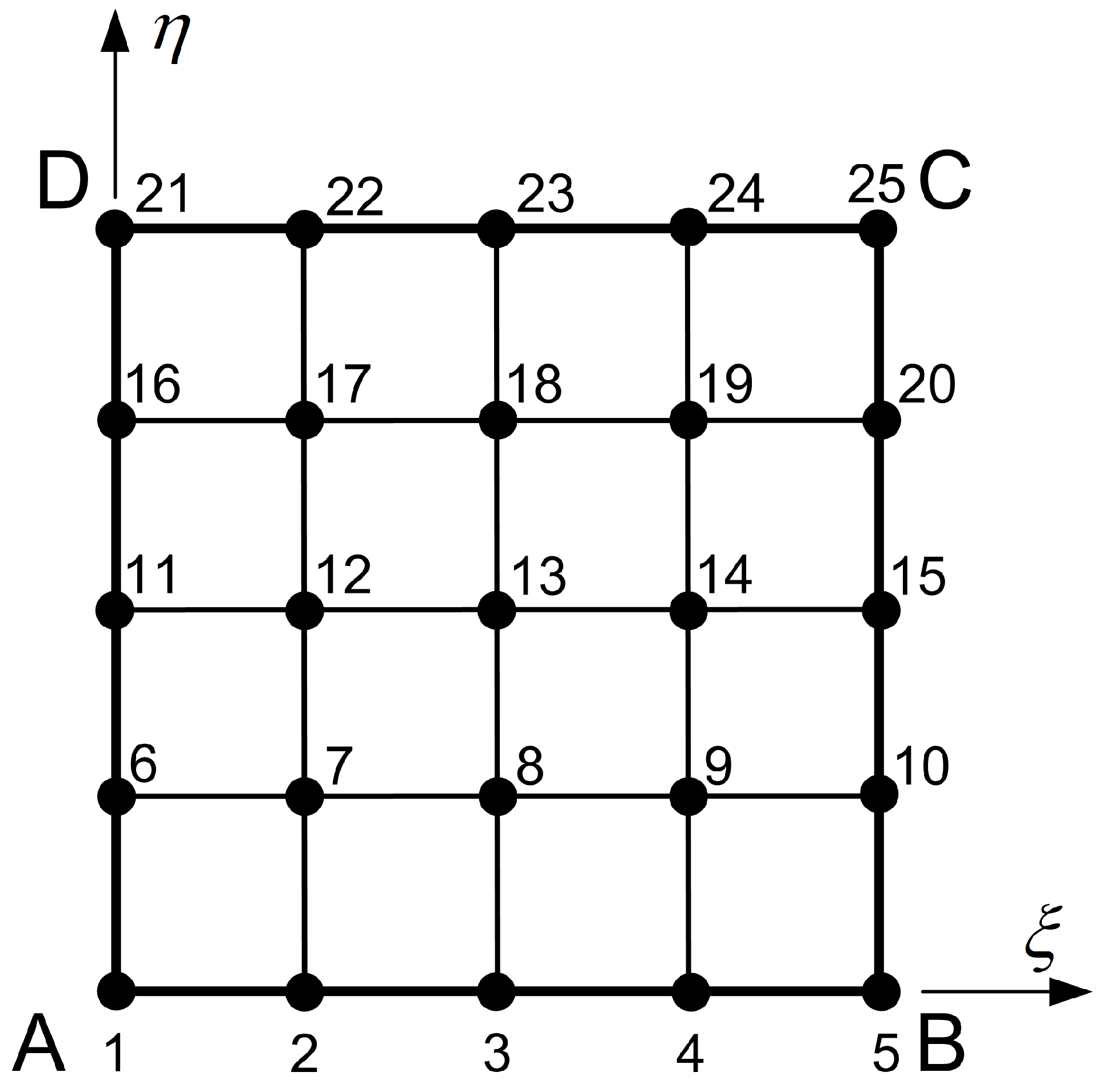
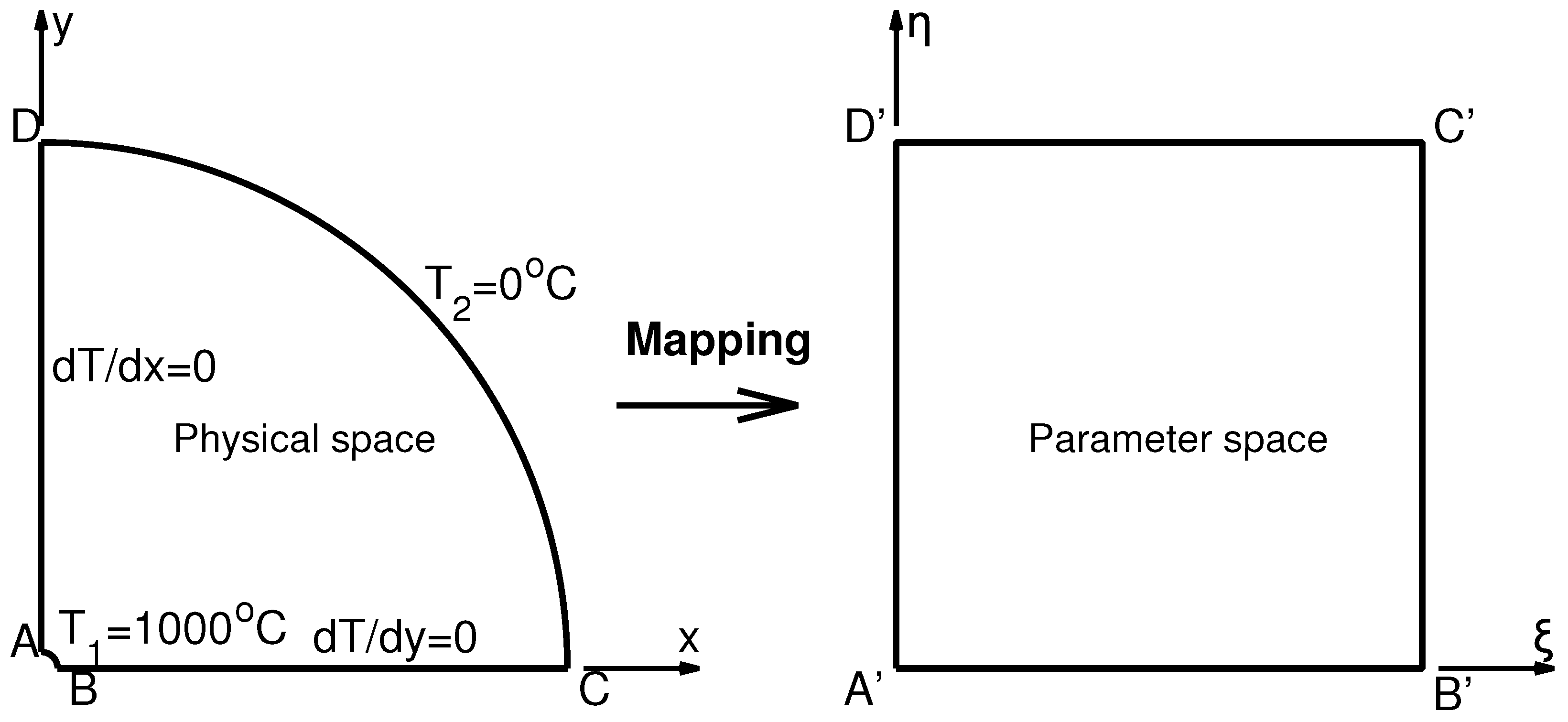
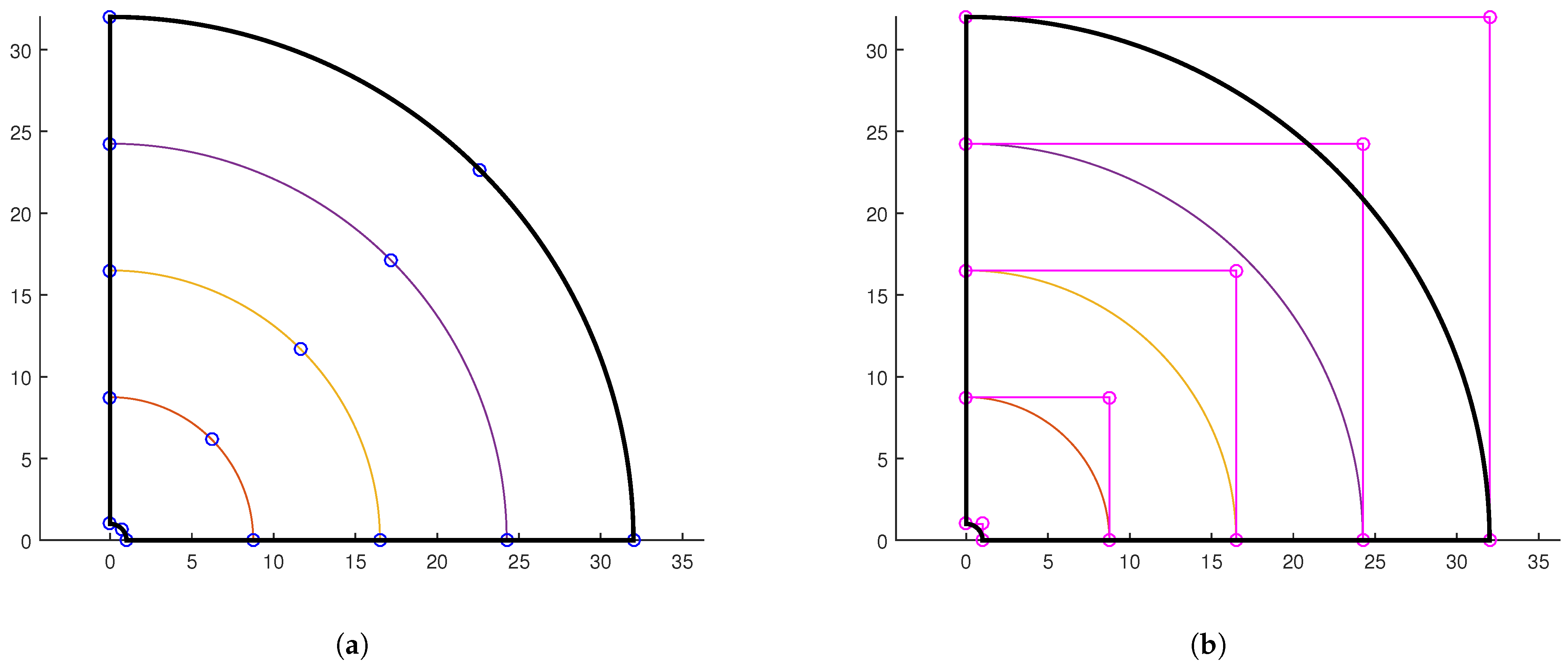

| Degree (p) | Bernstein (Equation (3)) | Lagrange (Equation (11)) |
|---|---|---|
| 2 | ||
| 3 | ||
| 4 | ||
| 5 | ||
| 6 |
| 0 | 1 | |||||
|---|---|---|---|---|---|---|
| 14.1258 | 15.1518 | 15.7224 | 23.4018 | 21.5982 | ||
| 14.1258 | 15.1518 | 15.7224 | 23.4018 | 21.5982 |
| p | Coordinates | ||||||
|---|---|---|---|---|---|---|---|
| Node-1 | Node-2 | Node-3 | Node-4 | Node-5 | Node-6 | Node-7 | |
| 2 | 1 | 0 | |||||
| 0 | 1 | ||||||
| 3 | 1 | 0 | |||||
| 0 | 1 | ||||||
| 4 | 1 | 0 | |||||
| 0 | 1 | ||||||
| 5 | 1 | 0 | |||||
| 0 | 1 | ||||||
| 6 | 1 | 0 | |||||
| 0 | 1 | ||||||
| Nodal Point | |||||
|---|---|---|---|---|---|
| 1 | 2 | 3 | 4 | 5 | 6 |
| 0° | |||||
| Coordinates | Weights | |||
|---|---|---|---|---|
| Point | x | y | z | w |
| 1 | −0.5773503 | −0.5773503 | −0.5773503 | 5.0717968 |
| 2 | −0.3128762 | −0.7095873 | −0.7095873 | 4.5200421 |
| 3 | 0.0000000 | −0.7540208 | −0.7540208 | 4.3572656 |
| 4 | 0.3128762 | −0.7095873 | −0.7095873 | 4.5200421 |
| 5 | 0.5773503 | −0.5773503 | −0.5773503 | 5.0717968 |
| 6 | −0.7095873 | −0.3128762 | −0.7095873 | 4.5200421 |
| 7 | −0.4133641 | −0.4133641 | −1.0000000 | 3.8660254 |
| 8 | 0.0000000 | −0.4573041 | −1.1200462 | 3.6449237 |
| 9 | 0.4133641 | −0.4133641 | −1.0000000 | 3.8660254 |
| 10 | 0.7095873 | −0.3128762 | −0.7095873 | 4.5200421 |
| 11 | −0.7540208 | 0.0000000 | −0.7540208 | 4.3572656 |
| 12 | −0.4573041 | 0.0000000 | −1.1200462 | 3.6449237 |
| 13 | 0.0000000 | 0.0000000 | −1.2798332 | 3.4045574 |
| 14 | 0.4573041 | 0.0000000 | −1.1200462 | 3.6449237 |
| 15 | 0.7540208 | 0.0000000 | −0.7540208 | 4.3572656 |
| 16 | −0.7095873 | 0.3128762 | −0.7095873 | 4.5200421 |
| 17 | −0.4133641 | 0.4133641 | −1.0000000 | 3.8660254 |
| 18 | 0.0000000 | 0.4573041 | −1.1200462 | 3.6449237 |
| 19 | 0.4133641 | 0.4133641 | −1.0000000 | 3.8660254 |
| 20 | 0.7095873 | 0.3128762 | −0.7095873 | 4.5200421 |
| 21 | −0.5773503 | 0.5773503 | −0.5773503 | 5.0717968 |
| 22 | −0.3128762 | 0.7095873 | −0.7095873 | 4.5200421 |
| 23 | 0.0000000 | 0.7540208 | −0.7540208 | 4.3572656 |
| 24 | 0.3128762 | 0.7095873 | −0.7095873 | 4.5200421 |
| 25 | 0.5773503 | 0.5773503 | −0.5773503 | 5.0717968 |
| Coordinates | Weight | |||
|---|---|---|---|---|
| Point | x | y | z | w |
| 1 | −0.5773503 | −0.5773503 | −0.5773503 | 5.0717968 |
| 2 | −0.3100080 | −0.6722704 | −0.6722704 | 4.6624403 |
| 3 | 0.0000000 | −0.7071068 | −0.7071068 | 4.5279702 |
| 4 | 0.3100080 | −0.6722704 | −0.6722704 | 4.6624403 |
| 5 | 0.5773503 | −0.5773503 | −0.5773503 | 5.0717968 |
| 6 | −0.6722704 | −0.3100080 | −0.6722704 | 4.6624403 |
| 7 | −0.3729805 | −0.3729805 | −0.8495711 | 4.1882599 |
| 8 | −0.0000000 | −0.3971773 | −0.9177419 | 4.0306408 |
| 9 | 0.3729805 | −0.3729805 | −0.8495711 | 4.1882599 |
| 10 | 0.6722704 | −0.3100080 | −0.6722704 | 4.6624403 |
| 11 | −0.7071068 | −0.0000000 | −0.7071068 | 4.5279702 |
| 12 | −0.3971773 | 0.0000000 | −0.9177419 | 4.0306408 |
| 13 | −0.0000000 | −0.0000000 | −1.0000000 | 3.8648644 |
| 14 | 0.3971773 | 0.0000000 | −0.9177419 | 4.0306408 |
| 15 | 0.7071068 | −0.0000000 | −0.7071068 | 4.5279702 |
| 16 | −0.6722704 | 0.3100080 | −0.6722704 | 4.6624403 |
| 17 | −0.3729805 | 0.3729805 | −0.8495711 | 4.1882599 |
| 18 | −0.0000000 | 0.3971773 | −0.9177419 | 4.0306408 |
| 19 | 0.3729805 | 0.3729805 | −0.8495711 | 4.1882599 |
| 20 | 0.6722704 | 0.3100080 | −0.6722704 | 4.6624403 |
| 21 | −0.5773503 | 0.5773503 | −0.5773503 | 5.0717968 |
| 22 | −0.3100080 | 0.6722704 | −0.6722704 | 4.6624403 |
| 23 | 0.0000000 | 0.7071068 | −0.7071068 | 4.5279702 |
| 24 | 0.3100080 | 0.6722704 | −0.6722704 | 4.6624403 |
| 25 | 0.5773503 | 0.5773503 | −0.5773503 | 5.0717968 |
Disclaimer/Publisher’s Note: The statements, opinions and data contained in all publications are solely those of the individual author(s) and contributor(s) and not of MDPI and/or the editor(s). MDPI and/or the editor(s) disclaim responsibility for any injury to people or property resulting from any ideas, methods, instructions or products referred to in the content. |
© 2025 by the author. Licensee MDPI, Basel, Switzerland. This article is an open access article distributed under the terms and conditions of the Creative Commons Attribution (CC BY) license (https://creativecommons.org/licenses/by/4.0/).
Share and Cite
Provatidis, C. A Note on Rational Lagrange Polynomials for CAGD Applications and Isogeometric Analysis. Mathematics 2025, 13, 3239. https://doi.org/10.3390/math13203239
Provatidis C. A Note on Rational Lagrange Polynomials for CAGD Applications and Isogeometric Analysis. Mathematics. 2025; 13(20):3239. https://doi.org/10.3390/math13203239
Chicago/Turabian StyleProvatidis, Christopher. 2025. "A Note on Rational Lagrange Polynomials for CAGD Applications and Isogeometric Analysis" Mathematics 13, no. 20: 3239. https://doi.org/10.3390/math13203239
APA StyleProvatidis, C. (2025). A Note on Rational Lagrange Polynomials for CAGD Applications and Isogeometric Analysis. Mathematics, 13(20), 3239. https://doi.org/10.3390/math13203239





